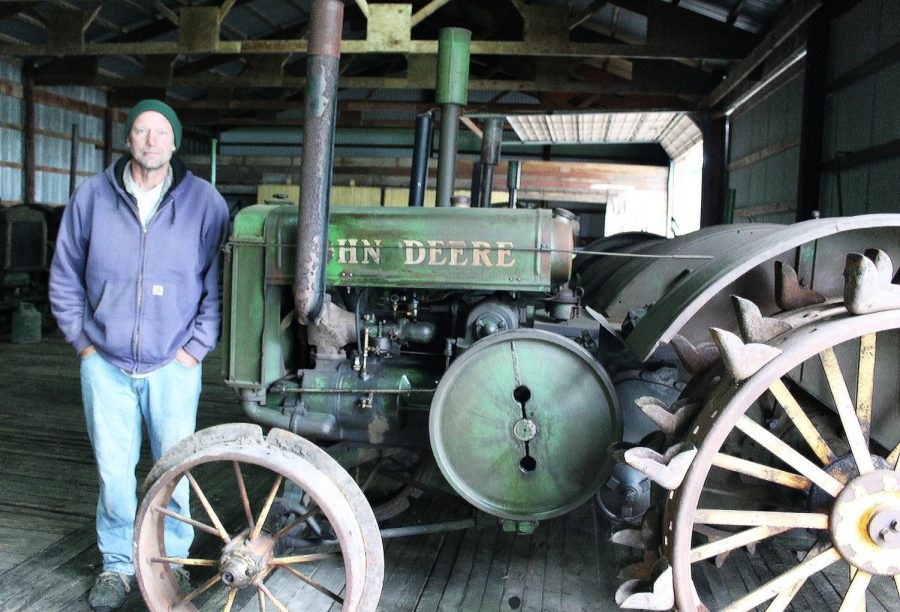Tractor collector amassing antiques since teenage years
November 4, 2020
Sure, every farmer needs a tractor or two, but does any farmer need 75 tractors?
He does if he’s Hans Knutson.
The Hutchinson, Minnesota man has been collecting tractors since he was a boy, and he credits his father with getting him started on the hobby.
Knutson’s father, Grant Knutson, began collecting antique John Deere tractors in 1976. The hobby rubbed off on Hans, who bought his first tractor at 15. Today, Knutson has an estimated 75 tractors scattered throughout four main sheds on his property. Each tractor is carefully selected and unique, and 19 of them are John Deere Model Ds.
“I just really enjoy it, and everyone’s got to have a hobby,” Knutson said.
Knutson’s wife, Tammy, is quick to point out that her husband could have a worse hobby than tractor collecting.
“Hans enjoys showing his tractors to people who appreciate them. He’s proud, but he doesn’t brag,” Tammy said.
Tammy does have mixed feelings about her husband’s collection, though. He spends quite a bit of time between farming, collecting and fixing them up, but she enjoys attending tractor shows and auctions with Knutson. They even drove all the way to Oregon together to pick up a tractor.
“I think if he wasn’t collecting the tractors, he’d be collecting something,” Tammy said.
Besides collecting them for enjoyment, Knutson shows his tractors at local events. He has:
- Attended every Heatwole Threshing Show, a local event, since 1980.
- Brought his tractors to Gathering of the Green, a John Deere show in Davenport, Iowa, the past couple of years.
- Attended Classic Green, a John Deere show in Columbus, Ohio.
- Attended the Le Sueur swap meet since he received his farm permit at age 15.
John Deere always has been his brand of choice. Knutson says he grew up with John Deere and his family farmed with them. John Deere is also one of the most popular tractor brands to collect in general, according to agweb.com.
Knutson finds most of his tractors at both online and in-person auctions. Websites such as yesterdaystractors.com are also helpful. His ultimate goal is to find a 1923 D. Only 11 are known to exist of the 50 that were built. Currently, Knutson is searching for a 1936 and a 1939 in their original conditions. Knutson says he prefers his tractors in their original used condition, simply because he enjoys the preservation of history, and he hopes to keep as many from being turned into scrap or melted down.
“I’m more into pretty tractors; I enjoy the shiny ones. He likes the original. He sees what they were, and he appreciates the history,” Tammy said.
According to the South Dakota State University Agriculture Heritage Museum, many museums prefer to learn from the original piece in the condition that it is in. Dents and scrapes can give people a peek into the farmers’ lives.
There also is a place for learning from restored, shiny tractors. Sometimes it is necessary to replace missing parts, as well as give an idea of what the equipment would look like brand new.
“The baling wire that held up a part, or the soup can over the exhaust pipe tell us how this farmer used his tractor,” Gwen McCausland, director of the Ag Heritage Museum, said. “The can over the exhaust pipe did not come off the factory floor like that, but every farmer did it because they didn’t want water to get in.”
Knutson is willing to go to great lengths to find tractors as original as possible. Besides the trip to Oregon, he has traveled to New Orlean and has even hired a person to pick up a tractor from California.
“Sometimes it’s necessary in order to find your specific model,” Knutson said.
Some tractors that Knutson buys need a little repair. Currently, he has a 1930 John Deere D in his shop that was found after sitting outside for many years, and it needs the entire engine replaced. Water damaged the engine, causing rust and deterioration, but Knutson continues to try and preserve the history.
“[I] almost think about my old Deere’s every day,” Knutson said. “[I] look forward to winters in the shop so I can work on them. If there is an upcoming auction, I can’t wait.”
Talking tractors
- John Deere Model D tractors were in production longer than any tractor in history (agriculture.com).
- Between 1923 and 1953, over 160,000 tractors were sold (agriculture.com).
- During the Great Depression, the United States sent about 900 tractors to Argentina. They could not be paid for so they had to be returned to the U.S. Hans Knutson owns one of the returned tractors.
- The John Deere D replaced the Waterloo Boy Ns after John Deere bought the Waterloo Gasoline Engine Co. (Tractordata.com).
























